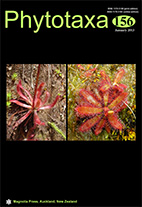Abstract
A new species in the genus Planothidium is described, Planothidium bagualensis sp. nov., from rivers of the Rio Pardo hydrographical basin, Rio Grande do Sul, southern Brazil. This account is based on light and scanning electron microscopy. This rather common species was misidentified in previous studies conducted in Brazil as belonging to either a group of species related to Planothidium lanceolatum and its varieties, or Planothidium frequentissimum. The presence of a cavum (“hood”) in the rapheless valve, however, clearly separates it from P. lanceolatum sensu stricto which has only a sinus (“rimmed depression”); the wider and longer cells of P. bagualensis, besides having ultrastructural differences, sets it apart from P. frequentissimum. Planothidium bagualensis is widely reported in freshwater environments of southern Brazil. The species reached up to 45% of relative abundance in epilithic samples from eutrophic lotic environments of the Rio Pardo hydrographical basin. Traditional weighted-averaging approaches (WA) were applied to model phosphates (P), chemical oxygen demand (COD), total dissolved solids and pH optima. P. bagualensis is formally described and the literature reviewed to delimitate its distribution. Published photomicrographs corresponding to Planothidium lanceolatum sensu stricto from South America were up to date only found in the Andean Cordillera (Chile and Bolivia), but until now this taxon has never been illustrated in Brazil.

